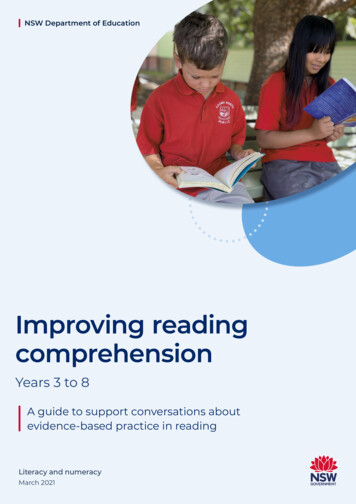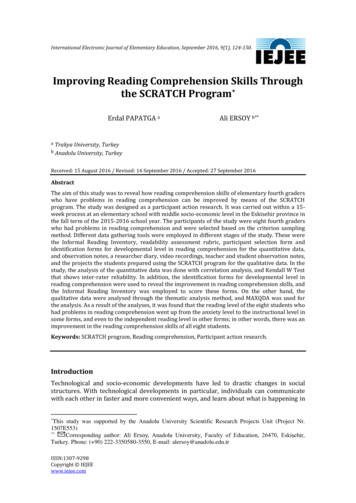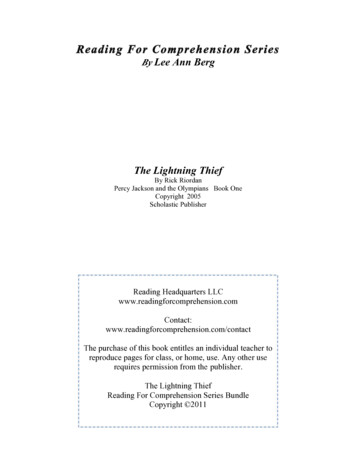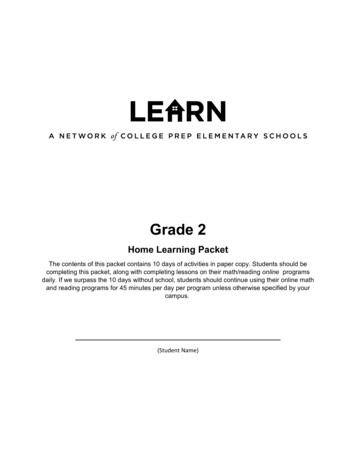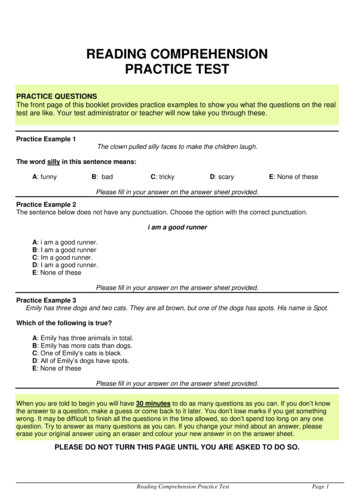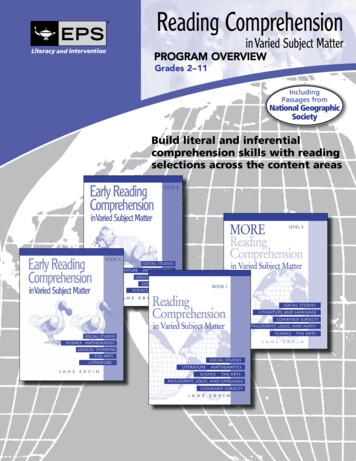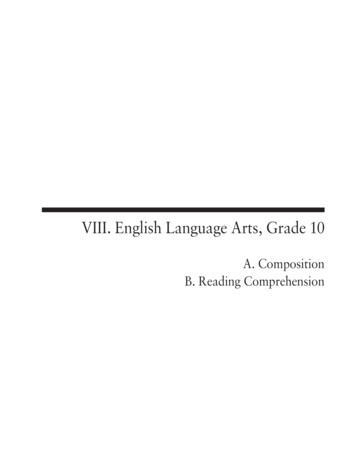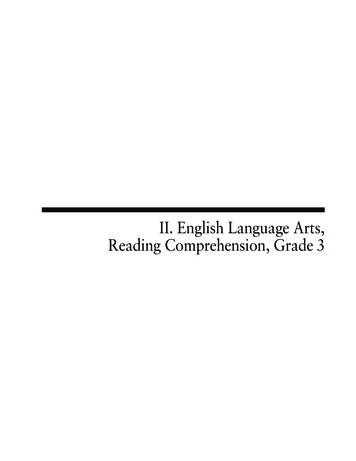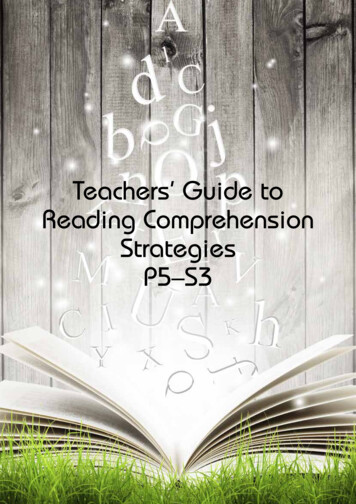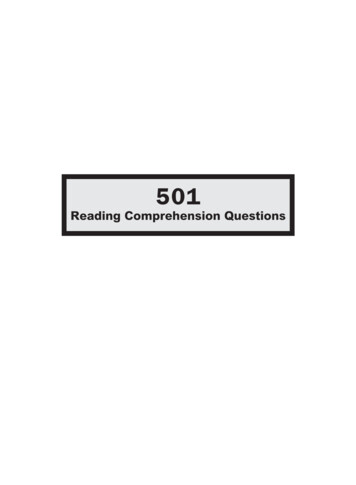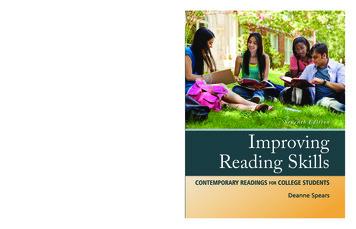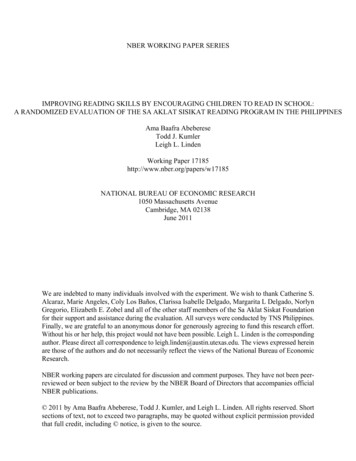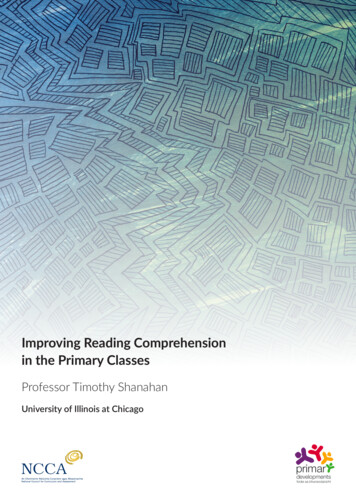
Transcription
Improving Reading Comprehensionin the Primary ClassesProfessor Timothy ShanahanUniversity of Illinois at Chicagoprimardevelopmentsforáis sa bhunscolaíocht
Improving Reading Comprehension in the Primary ClassesProfessor Timothy ShanahanUniversity of Illinois at ChicagoThe purpose of this paper is to explain what is entailed in improving readingcomprehension, particularly for primary school students, and to make recommendations as towhat schools must do if children are to become proficient comprehenders. As with anyendeavour, teaching reading comprehension is best approached from a clear understanding ofwhat it is that is to be taught.Definition of ComprehensionPerhaps the best current definition of reading comprehension is the one proposed bythe RAND Reading Study Group.1 Reading comprehension is a “process of simultaneouslyextracting and constructing meaning through interaction and involvement with writtenlanguage” (Snow, 2002). A characteristic that usually distinguishes one definition fromanother is whether it treats the reader and the reader’s actions as the central mechanism of theprocess or whether it is the text that is most determinate. The power of the RAND definitionis that it recognises that in reading comprehension both readers and texts are significant.Comprehending includes those instances when the reader must obtain—"extracting”—theexact message coded explicitly into a text (such as with a stop sign), and those that requireinference, interpretation, disambiguation, connection, and other actions that allow the“constructing” of a message based on the partial and imperfect cues to meaning that theauthor has coded into a text.Look at this passage from Roddy Doyle’s “Guess Who’s Coming for Dinner”:1In fall 1999, the U.S. Department of Education’s Office of Educational Research and Improvement (OERI)asked the RAND Corporation to examine how OERI might improve the quality and relevance of the educationresearch it funds. The RAND Reading Study Group was charged with developing a research framework toaddress the most pressing issues in reading comprehension.1
Larry Linnane liked having daughters. He got great value out of them, greatcrack.The second kid had been a boy and that was great too, having a son,bringing him to the football – Under 7, Under 8, Under 9, all the way up untilLaurence, the son, told him he thought he’d play better if Larry stayed athome. (Doyle, 2008, p. 1)The reader who is “extracting” meaning should learn from those lines that LarryLinnane liked being a father of both sons and daughters. That he had a son named Laurence,that he took his son to football matches, and that his son no longer wanted him to attend thosegames.But that, of course, is not all that good readers would gain from this text, because theywould also draw logical inferences based on background knowledge. It seems likely, forexample, that Laurence was named for his Da, that he is at least nine years old, and has anolder sister. Either Laurence has reached the age when children are embarrassed by theirparents for no precise reason, or perhaps Larry is such a vociferous “fan” of his boy’s footballthat he is doing something during the games that mortifies his second-born. In either case itappears that Laurence doesn’t want to hurt his father’s feelings—he isn’t saying that he’sembarrassed, just that he wants to play his best (which may be a euphemism forembarrassment).Readers must be able to combine meaning extraction and meaning construction ifthey are to grasp an author’s message, both stated and implied. Readers do this by using theinformation in a text and the knowledge that they bring to the text. It is not one or the other,but both, in combination.2
Theories Relevant to Reading ComprehensionThere are several theories of reading and reading comprehension that have beenadvanced by scholars (McNamara & Magliano, 2009). However, three particular theories arewidely used and serve as the foundation of much of what is currently known about readingcomprehension and the most effective instructional approaches to improving comprehension.The first of these is a theory of reading itself (the “simple view”), the second is morespecifically a theory of reading comprehension (the construction-integration model), and thethird (executive functioning and metacognition) are specific aspects of cognitive functioningbelieved to be implicated in the management or control of reading comprehension.Simple View of ReadingThe so-called “simple view” of reading claims that reading comprehension resultsfrom the coupling of efficient decoding with general oral language comprehension (Hoover& Gough, 1990):Decoding (D) x Language Comprehension (LC) Reading Comprehension (RC)Essentially, the idea is that decoding – that is translating print into oral language – is the onlyunique property of reading, and that once decoding has been implemented then readingcomprehension becomes equivalent to listening comprehension. According to the simpleview, strong reading comprehension will only result if students have strong decoding skillsand strong language comprehension.The simple view is intentionally simple; it doesn’t try to provide a detailedexplanation of reading comprehension as much as it posits what the necessary and sufficientenabling skills for comprehension would be. According to the simple view, students must beable to decode print into an oral representation. As such, reading requires an ability toperceive phonemes (the smallest meaningful units of language sound) separate from meaning3
(phonemic awareness), to match letters and sounds, and spelling patterns and pronunciations(phonics), and to do these things accurately, with sufficient speed and expression (fluency).In fact, research shows that teaching phonemic awareness, phonics, and oral readingfluency during the primary grades has a positive impact on students’ reading comprehension(National Institute of Child Health and Human Development [NICHD], 2000). Unfortunately,both the research and pedagogical communities have tended to neglect the role of orallanguage in this equation.However, the National Early Literacy Panel meta-analysed 63 studies that examinedthe relationship between early oral language ability and later reading comprehensionperformance (National Early Literacy Panel [NELP], 2008). When the studies included multicomponent measures of oral language (e.g., vocabulary, listening comprehension, syntax),then oral language was a powerful predictor of comprehension. Additionally, infants andtoddlers who lag in early language are more likely to suffer from later dyslexia (Snowling &Melby-Lervåg, 2016). These studies provide only correlational evidence, but they reveal aclose relationship between oral language and comprehension. As of yet, there have been fewstudies showing that oral language instruction improves reading comprehension, and thesehave focused mainly on vocabulary teaching. Vocabulary improvement has been shown tohave a positive impact on comprehension, but most of this research has focused on studentsbeyond the primary classes, and with those younger students the comprehension benefitshave been rather small (NICHD, 2000). Vocabulary, however, increases in importance asstudents make progress up through the classes.In any event, from this evidence it is fair to conclude that schools will not besuccessful in fostering proficient reading comprehension unless they provide students withthe necessary enabling skills. Although these enablers are not necessarily part of the4
comprehension process itself, reading comprehension would not be likely to occur withoutthem.Construction-Integration ModelThe next relevant theory is the construction-integration model of comprehension(Kintsch, 2010), This theory doesn’t address in detail these enabling or foundational readingskills, but assumes and depends upon proficient decoding, so that it can focus attention on theprocess of comprehension itself. According to the construction-integration model, the readerhas to translate a text base (that is the set of propositions that have been coded into text by awriter) into a situation model (which is a non-verbal mental representation in the reader’smind, the result of the reader’s processing and interpretation of the text).Initially in this model, the reader has to make sense of the semantic properties of thewords and the relationships between these words of the text. This process makes vocabularymeaning of prime importance in text interpretation, but also requires that the relations amongthe words signalled by the grammar and cohesion be interpreted as well. For example, takethis text:The turtle sat on a log. A fish swam under the log.To make sense of this pair of sentences readers would need to know the definitions ofturtle, sit, on, log, fish, swim, and under. And they would have to recognise that it was theturtle that was on the log and the fish that was under the log—and that this had already takenplace (past tense forms of to sit and to swim); these all being drawn from the syntacticrelationships coded into the text. Finally, readers would need to recognise the repetition ofthe word log and the use of the articles (a, the) as signals that the fish had swum under thesame log that the turtle was sitting on.These lexical (vocabulary, syntactic, and cohesive relations) are what Kintsch andcolleagues refer to as the microstructure of the textbase. Next, the reader must come to terms5
with the macrostructure. Macrostructure is the term used to refer to the semantic relations thatexist among larger sections of text. Thus, when reading a scientific article about the structureof the heart, the discourse might be divided into multiple sections: chambers, heart wall,pericardium, coronary circulation, and nerve supply—and readers have to recognise thesestructural parts and make sense of the connections among them.The interpretation of these micro- and macrostructures are essential parts of thecomprehension process, and they can easily be explained by various rule-based actions. Forinstance, in the earlier example, it is possible using lexical knowledge and logic alone torecognise that the fish swam under the turtle, even though the text was not explicit about thispoint. However, the reading comprehension process—developing a “situation model” fromsuch a text base—requires one more step if we are to describe the actual comprehensionprocess that the human mind implements.To construct a situation model from text, the reader has to eventually develop amental image or representation of the situation being described by the textbase. This mentalimage is based on the text information just described, but also upon a reader’s priorknowledge. This necessary reliance upon prior knowledge is the reason why most readerswould likely assume the fish that swam under the frog would look more like the fish picturedin Figure B than one in Figure A.Figure AFigure BTexts are incomplete representations of meaning. Authors—whether composingliterary narratives or historical or scientific expositions—do not provide complete6
descriptions of the protagonists or objects in a text, intentions, nor of the spatial, temporal, orcausative relationships (Zwaan & Radvansky, 1998). Readers must add imagery, emotion,and even personal experiences in order to comprehend a text. One can comprehend the “fishfrog story” above with low-level semantic knowledge and limited logical analysis, andwithout developing a situation model. However, research shows that such comprehensionwill be severely limited and short-lived, and inconsistent with the actual interpretations ofreaders under normal circumstances. Constructing situation models depends upon thereaders’ ability to combine prior knowledge with the text base to construct representations ofmeaning that instantiate the unspecified information. Research supports the value of teachingstudents to engage in constructing micro- and macrostructures and in developing situationmodels that include prior knowledge.Metacognition and Executive FunctionAdditionally, there are theories of metacognition and executive function that haverelevance to reading comprehension. Metacognition refers to awareness and regulation ofone’s own thought processes (Flavell, 1979), and executive function refers to the “commandand control” function that guides or directs all cognitive skills, including attention, memory,and effort (Butterfuss & Kendeou, 2017). These closely-allied skills play important roles inreading comprehension.Metacognition (thinking about thinking), for example, allows readers to monitor theircomprehension—and when that comprehension isn’t satisfactory, to adjust one’s approach tothe text. Perhaps readers will conclude that they don’t know the meaning of a particular wordand will look it up in a dictionary or will simply try re-reading the text with more focusedattention. Or, readers might decide that given the importance or difficulty of a particular textthey will read more carefully than usual, slowing their speed, or summarising each section asthey try to enhance their understanding and recall. All of those kinds of intentional cognitive7
actions that might be implemented prior to, during, or after reading are considered to be theprovince of metacognition.Executive control refers to even more subtle aspects of the management of cognitiveprocesses during comprehension. For example, when reading homonyms (words withidentical spellings and pronunciations, but different meanings) a reader has to initially resolvewhich meaning is the proper one, and then must inhibit the activation of the alternativemeanings for the remainder of the text rather than resolving that ambiguity again and again.Or, when a reader confronts an acronym used repeatedly in a text (such as DART for DublinArea Rapid Transit or DNA for deoxyribonucleic acid) it helps to commit such a term tomemory to facilitate comprehension. Or, readers might accord greater or less attention toparticular terms, phrases, clauses, sentences, paragraphs or ideas in a given text. These acts ofinhibition, memorisation, and attention are all implicated in reading comprehension and allfall within the realm of executive control.In summation, these theories explain that reading comprehension depends upon anefficient and fluent decoding process that allows readers to translate text to oral language.Additionally, readers need to know the meanings of words, and the relationships among thesewords as designated by the syntax and cohesive links included in a text. Comprehension thenrequires the ability to take this information that is stated explicitly or that is implied logicallyin the text and to combine that information with the reader’s prior knowledge in order tocreate a more complete and meaningful representation of the overall meaning of the text.Finally, during this entire process the reader’s cognitive executive functioning must monitorand manage this process, flexibly guiding attention, effort, and memory.How to Improve Reading ComprehensionThese definitions and theoretical foundations describe the nature of readingcomprehension and its component processes. Any instructional approach recommended for8
improving children’s reading comprehension should be consistent with these theoreticalconsiderations and should also possess clear and substantial empirical evidence showing itseffectiveness in improving comprehension. Given these criteria the followingrecommendations would set the best direction for a successful programme of readingeducation, particularly with primary school children; government policies that encourage andsupport these kinds of pedagogical directions—through teacher education and professionaldevelopment, supervision and evaluation, textbooks, programs, and assessment—are likely tobe most successful. Table 1 summarises these recommendations, grouping them into threesets: those recommendations aimed at developing the foundational knowledge and abilities,that while not being reading comprehension specifically, are essential to the development ofproficient comprehension; those recommendations focused specifically on the instructionalemphases and supports needed to teach reading comprehension effectively; and extensionsand elaborations that address encouraging students to both use and continue to grow theirability to comprehend text.1. Teach foundational skills.Most of the points made here will be focused on reading comprehension directly, butas the “simple view” makes clear, readers must learn to translate print to oral language inorder to enable comprehension. Given this, one should not be surprised that research findsthat instruction in various foundation skills, particularly during the primary classes, has apositive impact on reading comprehension. Specifically, studies show that instruction inphonological awareness, phonics, and oral reading fluency—all skills implicated in decodingprint efficiently—improve reading comprehension.Decoding instruction is important, in part, because of the limitations of the humanmind. Neural processing has severe limits in terms of capacity for attention and workingmemory (Craik & Lockhart, 1972). Brains can only pay attention to so much information at a9
given time; if comprehension is going to take place during reading, then the processing ofwords must become automatic (that is, capable of being carried out without consciousattention). Basically, the more conscious attention needed for decoding print, the lesscognitive capacity available to make sense of the meaning or implications of the messagebeing decoded (LaBerge & Samuels, 1974). Readers who are able to process print so fluentlythat these processes become automatic, will have greater cognitive capacity to devote tocomprehension.What are these essential foundational skills? There are several that deserve mention.Phonological awareness refers to the ability to perceive and operate on the sounds oflanguage separate from meaning. Young children, for instance, usually cannot perceivephonemes, the smallest distinct sounds that distinguish one word from another. That isproblematic given that English is an alphabetic language, that is a language in which thewritten symbols represent the sounds of the language rather than its meaning. Studies showthat young children (ages 4-6) can be taught to perceive the sounds of language and that suchinstruction improves these children’s progress with decoding and reading comprehension(Melby-Lervåg, Lyster, & Hulme, 2012; NELP, 2008; NICHD, 2000).Phonics refers to the knowledge of letters, letter sounds, and spelling patterns and theability to use this knowledge to figure out the pronunciation of printed words. Studies showthat explicit and systematic instruction in preschool, kindergarten, and Grades 1-2 leads toimprovements in the ability to read words, nonsense words, oral reading fluency, spelling,and reading comprehension (Jeynes, 2008; Kim, Petscher, Schatschneider, & Foorman, 2010;NELP, 2008; NICHD, 2000).Oral reading fluency refers to the ability to read text aloud accurately, with sufficientspeed, and proper expression. Oral reading fluency is a kind of mash up of decoding andreading comprehension. Reading the words of a text accurately and with sufficient speed10
requires a high degree of proficiency in decoding; while proper expression requires thatreaders be able to pause in ways that reflect the punctuation and meaning of the text.Admittedly, the comprehension noted here is not high-level interpretation of text, but more aninitial or immediate, online sense-making that appears necessary if deeper comprehension isto be accomplished (Breznitz, 2008. Research shows that oral reading fluency instructionleads to improved word recognition, oral reading fluency, and reading comprehension inGrades 1-4 (Kuhn & Stahl, 2003; NICHD, 2000).Reading comprehension benefits from substantial, high-quality instruction in all ofthese foundational skills during the primary school years. However, these skills are bestthought of as being necessary, but insufficient for promoting reading comprehension.Educational initiatives that aim to improve foundational skills alone would be expected tohave a very limited impact upon reading comprehension.2. Support language development including vocabulary.The simple view holds that once text has been decoded, readers then interpret the oralversion of the text in the same manner that oral language is usually interpreted.Consequently, language development should be expected to play an important role in thedevelopment of reading comprehension. In fact, research and theory reveal a strongrelationship between early language attainment and later reading achievement (NELP, 2008;Pickering & Garrod, 2013; Shanahan & Lonigan, 2012); and young children’s language ismuch more closely related to reading comprehension than to decoding skills. A recent reportfound that 10- and 11-year-old poor comprehenders (i.e., those with poor readingcomprehension despite good decoding abilities) had evidenced weak language skills as earlyas 15 months of age (Justice, Mashburn, & Petscher, 2013), and a meta-analysis of 86 studiesof second-language learners with comprehension deficits—but with good decoding—foundsubstantial oral language deficiencies (Spencer & Wagner, 2018).11
Language includes a multiplicity of skills including vocabulary, morphology, syntax,listening comprehension, and so on. These studies indicate that measures of all of these skillsare implicated in reading comprehension. Unfortunately, there are not experimental studiesshowing the effectiveness of instruction in each as an effective way of improving readingcomprehension. One important exception to this is vocabulary. Studies show that instructionin word meanings and the meaningful parts of words (morphology) can have a positiveimpact on reading comprehension (NICHD, 2000; Stahl & Fairbanks, 1986). Effectivevocabulary instruction promotes a rich representation of word meanings, focuses attention onthe relationships between words, fosters a use of the words in listening, speaking, reading,and writing, and provides plenty of review. Such instruction is beneficial across a wide rangeof ages and classes. Likewise, morphology instruction has been found to improve studentunderstanding of word meanings, even with younger students (Bowers, Kirby, & Deacon,2010).But what about other language components? Research shows that instruction canimprove oral language proficiency, at least with younger children, though whether such gainseventually translate into better reading comprehension has not yet been proven (NELP,2008). Similarly, studies have long shown that instruction can improve the listeningcomprehension of school-age children (Pearson & Fielding, 1983), but none of these studieschecked to see if these improvements translated to better reading comprehension, and thereare reasons to expect that such improvements may be supportive, but cross-modal transferwouldn’t necessarily be automatic.Given this it seems prudent to provide school-age children with explicit instruction invocabulary and morphology, and to provide language-supportive classroom environmentsthat encourage oral language use (e.g., discussion, oral presentation, storytelling, listeningcomprehension) and that provide students with sound oral language models. With preschool12
children and, perhaps, kindergartners (NELP, 2008) and with second-language learners(Pollard-Durodola, Mathes, Vaughn, & Cardenas-Hagan, et al., 2006) it makes sense to alsooffer explicit instruction in oral language.3. Knowledge use and knowledge development.A key aspect of reading comprehension is the integration of prior knowledge (that isthe knowledge the reader already has prior to reading) with the information extracted fromthe text (Cain, Oakhill, Barnes, & Bryant, 2001). With many texts, the relevant knowledge islikely to be pretty mundane—knowing that a character must have crossed a room or that thesun doesn’t shine at night. However, as students move up the grades, the need to readacademic texts increases and then the prior knowledge that matters most is academicknowledge (knowledge of literature, science, social studies, etc.).There are many things that educators can do to enhance students’ ability to developand use prior knowledge effectively in reading comprehension. For instance, it is often statedthat it doesn’t matter what texts students read as long as they read; the idea being that readingpractice is more important than any content considerations. However, to facilitate readingcomprehension growth over time, it makes sense that what students are asked to read inschool would present high-value content (e.g., excellent literature, informational texts thatexplore natural and social worlds, cultural touchstones). It would be equally wise to ensurethat students learned both the reading skills and the content of these texts. Such knowledgethen becomes part of the basis on which students read future texts. One way to increase thislikelihood is to have students reading multiple texts on a topic of importance. Of course,reading skills instruction is important, but it is equally important to ensure that contentsubjects are taught thoroughly as well in order to build coherent bodies of knowledge about arange of information.13
Beyond making sure students are increasing their knowledge of the world—evenduring reading instruction—it also helps to teach students strategies for bringing theirexisting knowledge to bear on the texts they are trying to read. Various procedures foractivating prior knowledge before and during reading have been found to be effective,including previewing the texts prior to reading (Burns, Hodgson, Parker, & Fremont, 2011;McCormick, 1989); making predictions about the text (Loranger, 1997); or using techniqueslike K-W-L in which students inventory what they already know about a text, what they wantto know, and after the reading, what they have learned (Ogle, 1986).4. Guided practice.As with any ability, practice is a key to proficiency; reading comprehension is nodifferent. This has long been recognised in reading instruction, in which guided readingpractice has been a pillar. Such practice most often takes the form of a group or class readingof a text under the guidance or supervision of a teacher. The group reads a text with thepurpose of comprehension, and the teacher, through the asking of questions and otherdevices, focuses students’ attention and facilitates their shared construction of an appropriatetext interpretation (the outward manifestation of a situation model). The underlying purposeof this process is that students, with such support, will develop coherent comprehension of atext and will improve the ability to acquire such comprehension independently in the future.There are several models available for guiding such discussions including the directedreading activity (Betts, 1946), Directed Reading-Thinking Activity (Stauffer, 1969), GreatBooks Discussions (Sandora, Beck, & McKeown, 1999), Guided Reading (Fountas &Pinnell, 2016), Socratic Questioning (Hirsh, 1997), Questioning the Author (Beck &McKeown, 2001), and so on.For example, guided reading has been promoted for more than 80 years. Within thismodel, teachers are encouraged to preteach potentially unknown vocabulary so that lack of14
word knowledge won’t interfere with comprehension; to provide or review students’ textrelevant prior knowledge so that this information will be easily accessible during the act ofreading; to establish a purpose for the reading to focus the readers’ attention on the mostrelevant and appropriate information (and suppressing attention to less importantinformation); to establish a reading plan, that is setting the amount of text to be read prior todiscussion of the information; and to ask questions about the text information, guiding thereaders to think about the ideas in the text, to generate appropriate and necessary inferences,and to construct a coherent memory of the text.Different approaches to guidance emphasise different aspects of the text or of thecomprehension process. The purpose here is not to champion any particular guidanceapproach over another—since research has not distinguished them on the basis of theircomparative effectiveness (Stahl, 2008). Instead, it is to encourage the inclusion of one ormore of these approaches in any programme aimed at enhancing reading comprehension, andto suggest some quality standards for any guidance of this kind.The key point is that whatever approach is taken to guiding reading comprehensionpractice the result should be a coherent representation of the text. This mental representationmight be externalised in the form of something like a written summary or retelling of the text,or it could be the discussion itself. Research shows that when good readers talk about a texttheir comments appear to be an effort to develop a coherent text representation (Coté &Goldman, 1999), and that when the texts themselves are incoherent (e.g., necessary causal orsequential links are absent or ambiguous, incidental ideas or tangents are emphasised toomuch) then readers have more trouble comprehending (Lien & Chang, 2016; Taraban, 2003).Research has even revealed how the brain processes different kinds of information—processing information of central importance more and in different neural locations thanperipheral information (Swett, Miller, Burns, Hoeft, et al., 2013). That suggests that the15
guidance and questioning teachers use to lead students through a text should result in thereaders’ constructing coherent causal or sequential chains of information (Stiegler-Balfour,Benassi, Tatsak, & Taatjes, 2014).Studies have shown that texts that facilitate the development of coherent mentalrepresentations provide
view, strong reading comprehension will only result if students have strong decoding skills and strong language comprehension. The simple view is intentionally simple; it doesn’t try to provide a detailed explanation of reading comprehension as much as it posits what the necessary and sufficient enabling ski
